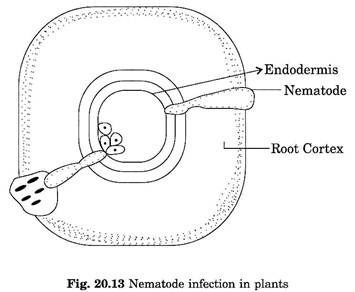In this article we will discuss about the nematode resistance in plants.
Nematodes predate on large number of plants and inflict considerable damage to economically important crops. Plant nemotades are either living outside the root (ectoparasite) or living inside the root (endoparasite). The endoparasitic nematodes divided into two groups. One is cyst nematodes include, heterodera and globodera and root knot nematode of the genus Meloidogyne (Fig. 20.13).
The meloidogyne has a world-wide distribution and capable of infecting more than 200 plant species. Root-knot nematodes larvae enter the roots of host plant and establish inside after having contact with vascular system. Once nematodes established, induce the formation of giant cells from which they feed.
Whereas cyst nematode feed from the syntium, which is composed of several cells after fusion of protoplast. The characteristic symptom A infected plants is the appearance of dozons of root galls, in which nematodes are embedded. Thus plants are severely affected, by growth retardation.
In addition, nematodes are able to down regulate genes within feeding cells and also activate host genes in order to faciliate feeding structure. Several conventional methods such as crop rotation, fumigation, cultivating resistance crops are currently employed to control nematodes. The toxicity of nematocide restricted its use in several countries.
Therefore, strategies for the nematode resistance are a major goal in plant breeding programmes. Resistance genes (R) when introduced into the crops through breeding methods exhibit resistance symptoms to ward-off nematodes. It is however several crops species lack of resistance genes. In breeding for nematode resistance, both polygenic and monogenic type of resistance has now been mapped.
Molecular marker and in marker assisted nematode selection is the novel method for the mapping of natural resistance gene locus and this has been implicated in the production of nematode resistance plants. Marker-based techniques such as RFLP, AFLP and RAPD are used for mapping of resistance gene.
Gene gro I, resistance to root-cyst nemato G. rostochinensis have been mapped with molecular markers confers resistance to both to the root knot nematode to Meloidogyne incognita and potato Macrosiphem euphorbiae.
Development of several nematodo resistant genes has been accomplished using positional cloning of natural nematodo resistant genes. The wild sugar beet contains resistance genes like HS1, HS2, and HS3 that confer complete resistance but resistance genes are absent in cultivated Beta species.
Therefore, nematode ‘R’ genes have been transferred from wild into cultivated sugar beet by positional cloning approach. Another classic study, M1 – 1 of a lycopersicum peruvianum gene conferring resistance to agriculture pest, root-knot nematodes has been cloned using AFLP selection. This gene in susceptible tomato.
